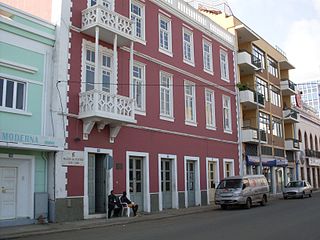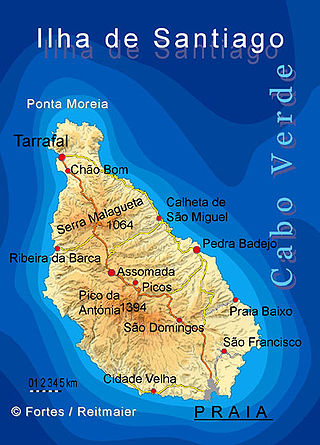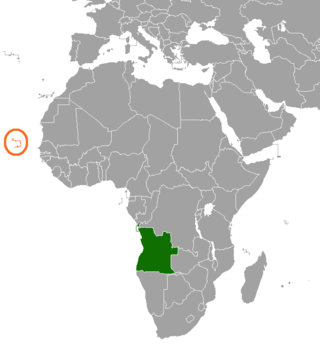
Praia is the capital and largest city of Cape Verde. Located on the southern coast of Santiago island, within the Sotavento Islands group, the city is the seat of the Praia Municipality. Praia is the economic, political, and cultural center of Cape Verde.

Cape Verde is known internationally for morna, a form of folk music usually sung in the Cape Verdean Creole, accompanied by clarinet, violin, guitar and cavaquinho. Funaná, Coladeira, Batuque and Cabo love are other musical forms.

Germano Almeida is a Cape Verdean author and lawyer.

Santiago is the largest island of Cape Verde, its most important agricultural centre and home to half the nation's population. Part of the Sotavento Islands, it lies between the islands of Maio and Fogo. It was the first of the islands to be settled: the town of Ribeira Grande was founded in 1462. Santiago is home to the nation's capital city of Praia.

The Democratic and Independent Cape Verdean Union is a conservative political party in Cape Verde.

Claridade was a literary review inaugurated in 1936 in the city of Mindelo on the island of São Vicente, Cape Verde. It was part of a movement of cultural, social, and political emancipations of the Cape Verdean society. The founding contributors were Manuel Lopes, Baltasar Lopes da Silva, who used the poetic pseudonym of Osvaldo Alcântara, and Jorge Barbosa, born in the Islands of São Nicolau, Santiago and São Vicente, respectively. The magazine followed the steps of the Portuguese neorealist writers, and contributed to the building of "Cape Verdeanity", an autonomous cultural identity for the archipelago.
Manuel António de Sousa Lopes was a Cape Verdean novelist, poet and essayist. With Baltasar Lopes da Silva and Jorge Barbosa he was a founder of the journal Claridade, which contributed to the rise of Cape Verdean literature. Manuel Lopes wrote in Portuguese, using expressions typical for Cape Verdean Portuguese and Cape Verdean Creole. He was one of those responsible for describing world calamities of the droughts that caused several deaths in São Vicente and Santo Antão.

Os Flagelados do Vento Leste is a novel published in 1960 by Cape Verdean author Manuel Lopes. Along with Claridade, Baltazar Lopes participated with Manuel Lopes and Jorge Barbosa with founded members of the review and the name was the movement in the main activists of the same.

São Jorge is a settlement in the central part of the island of Santiago, Cape Verde. It is part of the São Lourenço dos Órgãos municipality. In 2010 its population was 6. It is situated 2.5 km southwest of João Teves and 4 km southeast of Picos. Its elevation is 319 meters.

Angola and Cape Verde are members of the African Union, Community of Portuguese Language Countries, Group of 77 and the United Nations.

Primary school education in Cape Verde is mandatory between the ages of 6–14 and free for children ages 6–12. In 1997, the gross primary enrollment rate was 148.8%. Primary school attendance rates were unavailable for Cape Verde as of 2001. While enrollment rates indicate a level of commitment to education, they do not always reflect children's participation in school. Textbooks have been made available to 90% of school children, and 90% of teachers have attended in-service teacher training. Its literacy rate as of 2010 ranges from 75 to 80%, the highest in West Africa south of the Sahara.
André Álvares de Almada was a Cape Verdean writer, trader and explorer of mestiço (mixed) descent. He was one of the first recorded Cape Verdean writers.
Yara dos Santos is a Cape Verdean writer.

Humberto Duarte Fonseca, was one of the first Cape Verdean scientists.
Tomé Varela da Silva is a Cape Verdean writer, poet, philosopher and anthropologist which he studies in an orally tradition and the musical heritage of Cape Verde in which he favored for the usage of Cape Verdean Creole in literature. Himself, he is the author of several poets and stories. His most important works were published in the 1980s and the 1990s
Manuel Veiga is a Cape Verdean writer, a linguist with references in the national and international level and a politician. He was minister of culture of his country from 2004 to 2011.

The Pro-Cathedral of Our Lady of Grace is a catholic church on the east side of Praça Alexandre Albuquerque, in the city centre of Praia, on the island of Santiago, Cape Verde. The church was built between 1894 and 1902. It is the seat of the Roman Catholic Diocese of Santiago de Cabo Verde, which was created in 1533. It is under the pastoral responsibility of Arlindo Gomes Furtado Cardinal.
The Culture of the Island of Santiago, Cape Verde is the richest in the nation, with a range of customs and practices common in the islands,

Colá is a musical genre of Cape Verdean music













